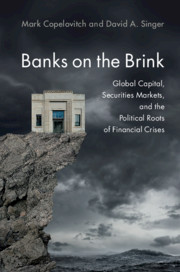Book contents
- Banks on the Brink
- Political Economy of Institutions and Decisions
- Banks on the Brink
- Copyright page
- Dedication
- Contents
- Figures
- Tables
- Preface
- Acknowledgments
- 1 The Politics and Economics of Financial Instability
- 2 Banking Crises, Capital Flows, and Financial Market Structure
- 3 Capital Inflows, Market Structure, and Banking Crises
- 4 O Canada? Unraveling the Mystery of Canadian Bank Stability
- 5 Finanzplatz Deutschland
- 6 Policy Responses
- References
- Index
- Political Economy of Institutions and Decisions
2 - Banking Crises, Capital Flows, and Financial Market Structure
Published online by Cambridge University Press: 10 February 2020
- Banks on the Brink
- Political Economy of Institutions and Decisions
- Banks on the Brink
- Copyright page
- Dedication
- Contents
- Figures
- Tables
- Preface
- Acknowledgments
- 1 The Politics and Economics of Financial Instability
- 2 Banking Crises, Capital Flows, and Financial Market Structure
- 3 Capital Inflows, Market Structure, and Banking Crises
- 4 O Canada? Unraveling the Mystery of Canadian Bank Stability
- 5 Finanzplatz Deutschland
- 6 Policy Responses
- References
- Index
- Political Economy of Institutions and Decisions
Summary
The global and European financial crises since 2008 have made abundantly clear, once again, the extremely serious economic and political consequences of financial instability. In their study of the costs of systemic banking crises in industrialized and emerging markets since World War II, Reinhart and Rogoff (2009a) find that crises trigger “deep and prolonged” asset market collapses; on average, real estate markets collapse by 35 percent over six years, while stock prices fall by more than 50 percent, on average, over more than three years. The damage to the real economy from financial crises is even more severe: economic output in the wake of crises falls, on average, by 9 percent over two years, while unemployment rises by 7 percent over more than four years. Similarly, Romer and Romer (2017) find that GDP in OECD countries is typically 9 percent lower five years after an extreme financial crisis.
- Type
- Chapter
- Information
- Banks on the BrinkGlobal Capital, Securities Markets, and the Political Roots of Financial Crises, pp. 22 - 42Publisher: Cambridge University PressPrint publication year: 2020



